-
Key Takeaways
-
What Is a VOR Approach?
-
Understanding the Components of VOR
- Signal Transmission
- Ground Station and Radials
- VOR Receiver
-
Flying a VOR Approach With or Without GPS
- GPS Integration
- Traditional VOR Approach Steps
-
Step-by-Step Guide to Flying a VOR Approach
- Study the VOR Approach Chart
- Preparation
- Descent and Approach
- Final Descent and Landing
-
Common Challenges and Tips
- Interference and Signal Limitations
- Staying Aligned With the Approach Path
- Pro Tips
-
Conclusion
Are you curious about flying a VOR approach? If you’re aiming to master instrument-rated flying, it’d be valuable to learn about VOR approaches. But what exactly is it, and do you really need it in this day and age?
We’ll cover what a VOR approach is, how to fly it step-by-step, and even whether GPS can replace it in today’s navigation.
Ready to make VOR approaches easy?
Key Takeaways
- VOR approaches use ground-based radio signals to guide aircraft safely to waypoints and landing.
- Proper identification and tracking of VOR radials is essential to flying these approaches.
- Understanding both traditional and GPS-integrated methods gives you more options in various weather conditions.
- Consistent instrument scanning and course corrections are required to maintain a precise approach.
What Is a VOR Approach?
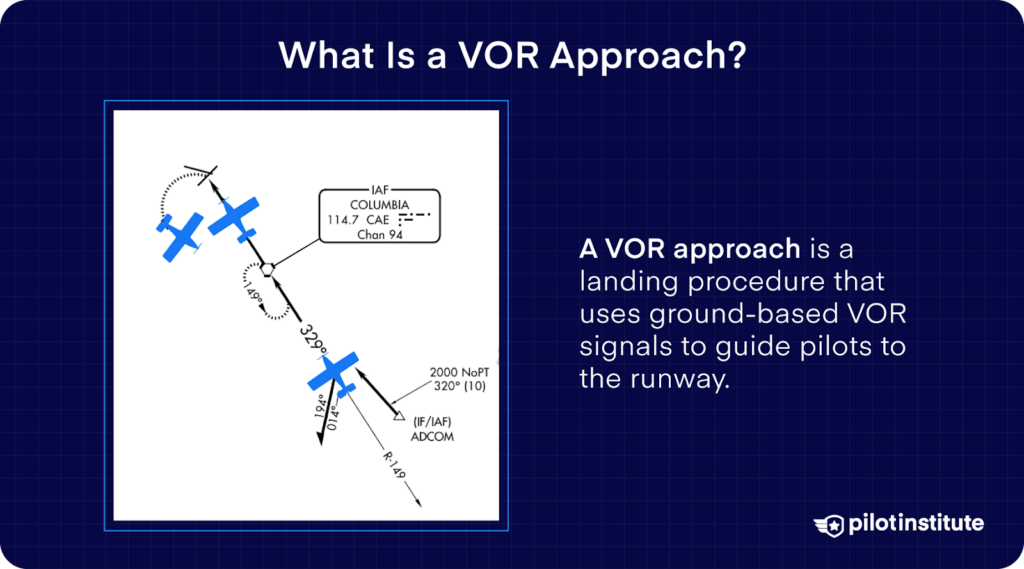
A VHF Omnidirectional Range (VOR) approach might seem challenging at first, but like anything, practice makes perfect. This type of approach is a non-precision instrument procedure that uses ground-based radio signals to guide you safely to a waypoint or the runway, even when visibility is poor.
A VOR approach gives you accurate guidance by following specific VOR radials. Unlike an Instrument Landing System (ILS), a VOR approach only provides horizontal guidance. So, you must manage the descent and altitude using the VORs published step-down fixes and minimum descent altitudes (MDAs).
Why are VORs so important?
Suppose you’re 10 miles out from the airport, and your GPS just quit. What then? VOR approaches act as backup procedures when GPS isn’t available or when airports do not have an ILS approach.
While modern aircraft often rely on GPS for navigation, some areas may have poor signals or outages. Mastering VOR approaches will provide a reliable way to get to your destination safely.
Understanding the Components of VOR
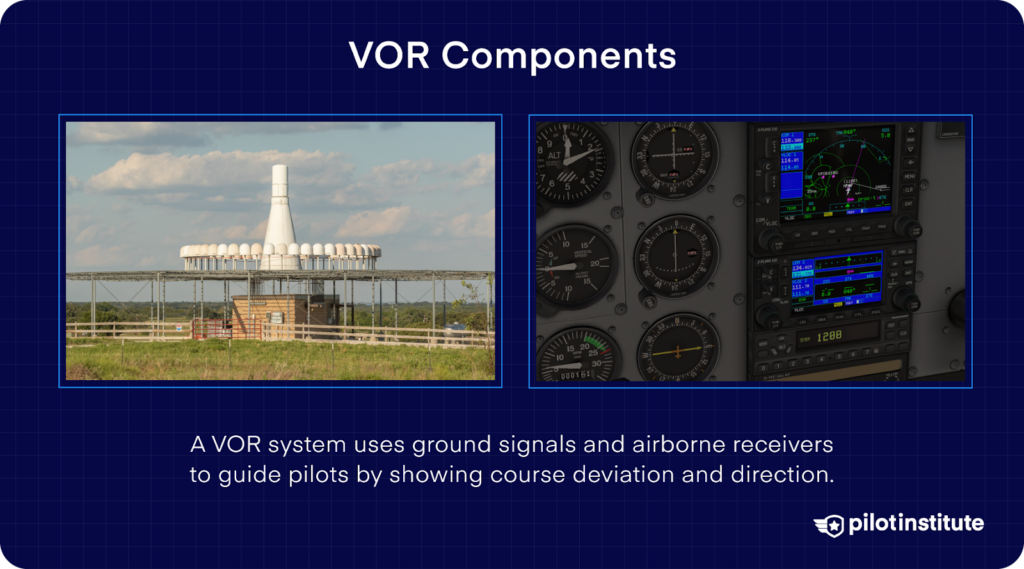
Understanding the components of a VOR will help you better understand the overall system. VOR uses ground-based stations, airborne receivers, and radio signals to provide a navigation network that has safely guided pilots for many years. Let’s dive into how VOR works.
Signal Transmission
VOR stations act like lighthouses for aircraft, but instead of light, they emit radio signals in all directions. The system relies on two types of signals: one that rotates and another that pulses in all directions.
Your aircraft’s VOR receiver compares these signals to pinpoint your exact position from the station.
The beauty of this system is its straightforwardness and dependability. Unlike GPS, which depends on satellite signals, VOR stations function independently on the ground, making them less susceptible to widespread outages.
Ground Station and Radials
VOR radials work like the spokes of a wheel radiating outwards from the VOR station. Each radial indicates a specific magnetic course from the station, numbered between 001 to 360 degrees.
If you’re on the 090 radial, you’re positioned directly east of the station. Understanding radials is important, as they form the basis of your VOR approach.
VOR Receiver
Your aircraft’s VOR receiver provides navigation information through two main components:
- The CDI (Course Deviation Indicator) shows whether you’re to the left or right of your intended course.
- The TO/FROM indicator indicates whether you’re flying toward or away from the station.
With practice, understanding these instruments will become second nature to you.
Flying a VOR Approach With or Without GPS
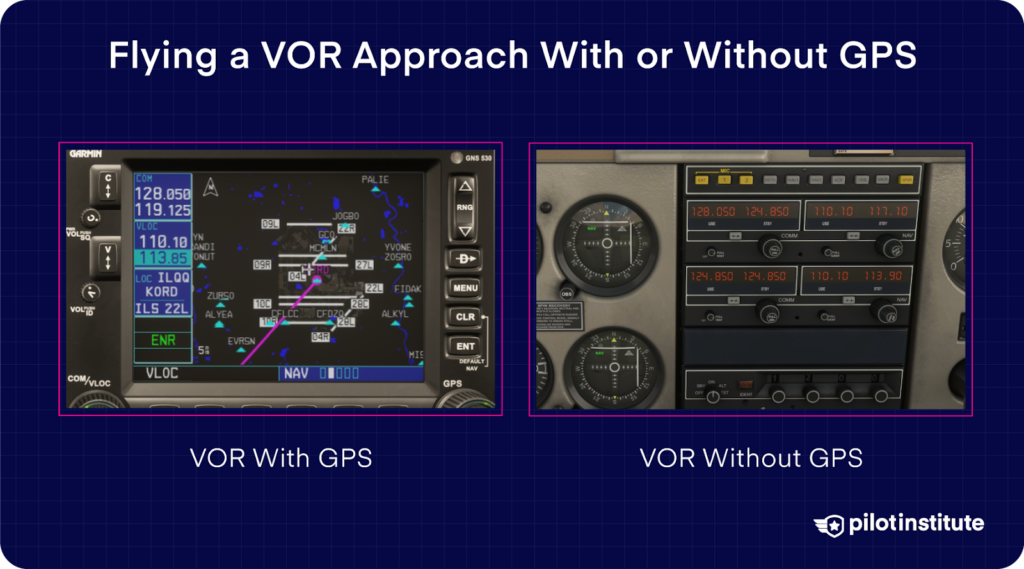
Flying a VOR approach consists of a combination of traditional radio navigation with modern technology. While GPS adds convenience, learning how to fly these approaches using only VOR signals is a skill every instrument pilot must master.
GPS Integration
Modern aircraft combine GPS with VOR approaches to improve situational awareness. While this can be beneficial, you need to make sure that your GPS is correctly set up as a backup for the VOR approach.
Federal Aviation Administration (FAA) regulations clearly state that GPS can support but not substitute VOR guidance during a VOR approach unless authorized.
Sometimes, pilots tend to depend too much on their GPS displays. It’s important to remember that the primary guidance comes from the VOR signals themselves. Use GPS as a backup, not as your main reference.
Traditional VOR Approach Steps
- Tune in and identify the VOR frequency (108.0–117.95 MHz).
- Set the inbound course via the Omni-Bearing Selector (OBS).
- Intercept the desired radial or course.
- Follow published descent altitudes from the approach chart.
- Maintain course alignment using CDI guidance.
Step-by-Step Guide to Flying a VOR Approach
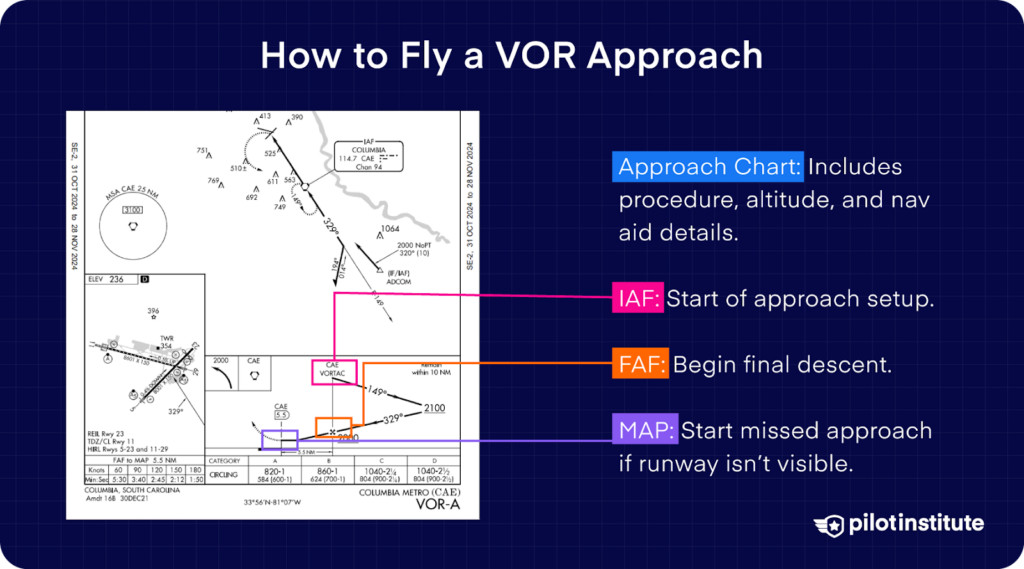
Successfully flying a VOR approach requires good preparation and skill. Like building blocks, each phase of the approach builds upon the previous one, creating a smooth descent to landing. You should break down the VOR approach procedure into a manageable series of tasks.
Study the VOR Approach Chart
Every VOR approach has a published chart with details on the approach procedure, minimum altitudes, and navigational aids. This approach chart, also called an approach plate, provides all the information you need to fly a VOR approach.
- Initial Approach Fix (IAF): This is a specific point where the approach procedure starts, allowing you to set up the aircraft with the inbound course for the final approach.
- Final Approach Fix (FAF): This marks the point where the final descent begins, and you should be ready for landing at this stage.
- Missed Approach Point (MAP): This is the location where you must initiate a missed approach if you cannot see the runway.
- Missed Approach Procedure: This shows the route and steps to follow if you are unable to land.
Preparation
Being prepared is most important when flying a VOR approach. Taking the time to prepare helps reduce workload during the other phases. Follow these steps to begin the VOR approach:
- Review the approach plate.
- Set your VOR frequency and confirm the identifier.
- Turn the OBS knob until the CDI needle centers and the TO position appears.
- Turn to the heading shown on the OBS.
- Complete your approach briefing, which should include:
a. Initial approach altitude.
b. Location of the FAF.
c. Minimum descent altitude.
d. Missed approach point.
e. Missed approach procedures.
Descent and Approach
Before flying in for a landing, you’ll want to get established on course early, so you’re not chasing that needle later. During the descent and approach phase, you should:
- Track the initial approach fix using the CDI.
- Maintain the published altitudes until you reach the final approach fix or Minimum Descent Altitude (MDA).
-
-
-
- Follow the published descent gradient from the approach chart.
- Cross-check your altitude as you descend to each fix.
- Make small corrections to maintain course alignment.
-
-
To maintain course alignment, you should keep the CDI needle centered. When the needle moves left, you need to make a left turn correction to get back on course and vice-versa.
Here’s a Simple Way to Remember
- If the needle is to the left → turn left.
- If the needle is to the right → turn right.
- If the needle is centered → you are on course.
Note: We’ve all been there, watching that CDI bounce back and forth. Making small corrections (5 to 10 degrees) early on can prevent the need for larger adjustments later.
Final Descent and Landing
The landing phase of the VOR approach requires the most attention, so you’re fine-tuning now, not making big changes. Also, avoid fixating on any single instrument. Scan all the instruments periodically to cross-check your position.
- Maintain the final approach course using small corrections.
- Monitor your descent rate and altitude.
- Look for the runway once you reach the MDA.
- Execute a missed approach if the runway is not in sight.
Remember to always notify ATC when executing a missed approach.
Note: The CDI needle grows more sensitive as you approach or fly over a VOR station (known as the cone of confusion), so even a slight deviation can cause a noticeable deflection. If that happens, simply maintain and hold the heading you were flying.
Common Challenges and Tips
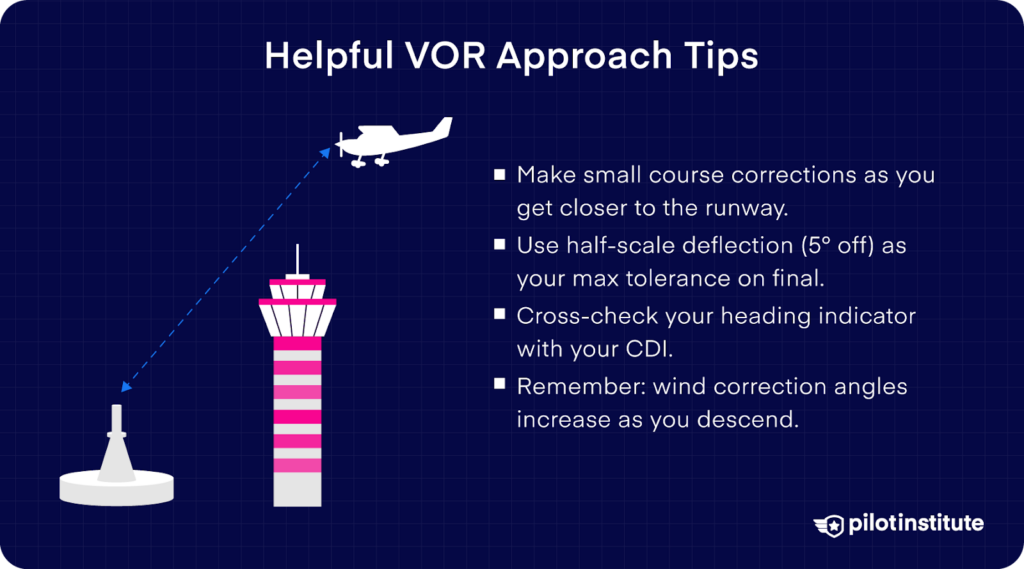
Even the most experienced pilots face challenges when flying VOR approaches. Weather, terrain, and equipment limitations can all affect VOR navigation. With the right knowledge, you can confidently handle any challenges during your approach.
Interference and Signal Limitations
VOR signals rely on Radio Line-of-Sight (RLOS) between the transmitter and the aircraft’s receiver. Obstacles like a mountain between your aircraft and the VOR station can block the signal.
Other limitations include:
- Limited range at lower altitudes.
- Signal interference from terrain.
- Disruptions caused by weather.
You should address signal issues right away:
- Check signal strength, such as fluctuations on the CDI needle.
- Cross-verify location with other navigation sources like GPS when possible.
- Be ready to execute a missed approach if the signal becomes unreliable.
What should you do if your VOR signal becomes weak? You should switch to a different navigation method, such as GPS or another VOR, or reach out to Air Traffic Control (ATC) for further assistance.
Staying Aligned With the Approach Path
VORs are extremely accurate, usually within 1 degree, so your course alignment typically ranges from plus or minus 1 degree. However, several factors can influence radial accuracy, such as aircraft instrument errors or distance.
Distance from the station plays a major role. An aircraft can receive VOR signals from a distance of up to 130 nautical miles. If your aircraft moves farther away from the VOR, you must fly at a higher altitude to receive the signal.
Pro Tips
- Make small course corrections as you get closer to the runway.
- Use half-scale deflection (5° off) as your max tolerance on final.
- Cross-check your heading indicator with your CDI.
- Remember: wind correction angles increase as you descend.
Conclusion
Feeling confident about VOR approaches now? They may seem like old-school navigation, but knowing how to fly one is still an important skill for any instrument-rated pilot.
Mastering this approach strengthens your fundamentals and prepares you for a range of real-world flying situations. Next time you see a VOR approach on your chart, you’ll know exactly what to do!
If you feel like you need a little more explanation of instrument approaches, we recommend checking out “Instrument Rating Made Easy”.



